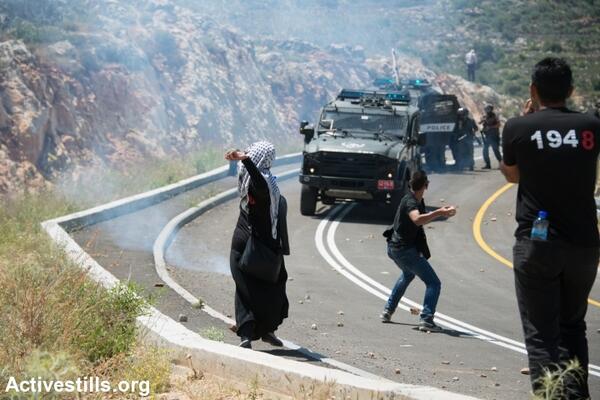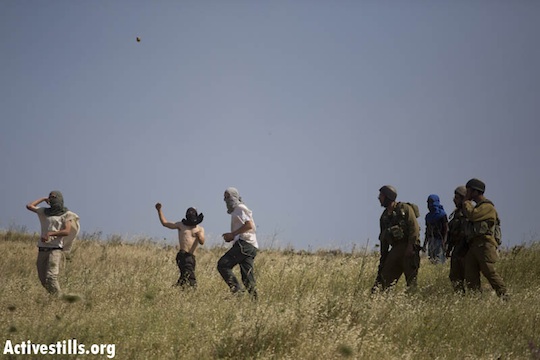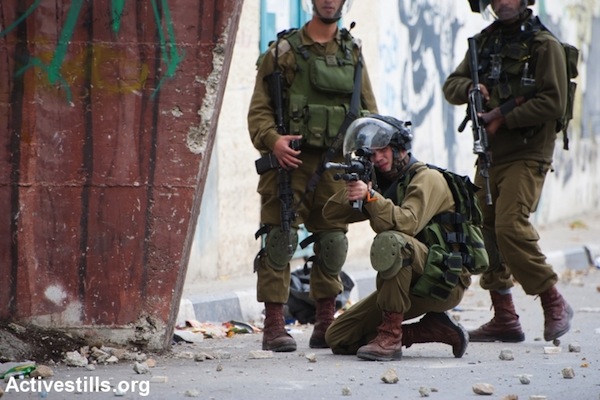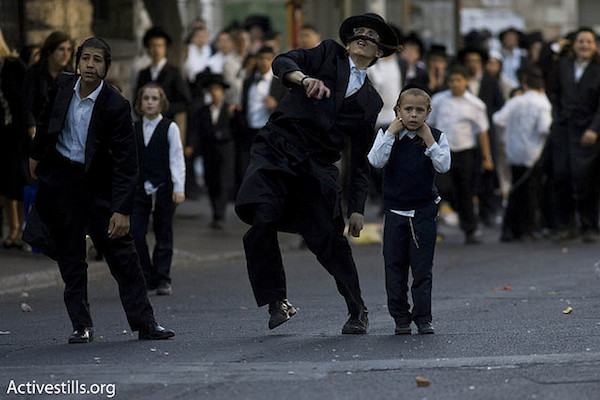An IDF brigade commander earns praise from the political establishment for killing a Palestinian stone-thrower, while soldiers are commended for using ‘restraint’ in the face of Jewish stone-throwers. The fourth installment in a series examining the case files of soldiers who killed unarmed Palestinian civilians. [Read parts one, two, three, and four]
By John Brown* and Noam Rotem
Translated from Hebrew by Ofer Neiman

On Friday, July 3, Colonel Yisrael Shomer, commander of the Binyamin Brigade, shot two bullets into the back of 17-year-old Muhammad Ali-Kosba, and another in his head. Shomer claimed the boy was throwing stones at his vehicle.
The political establishment was full of praise for the colonel’s conduct due to the “life threatening” situation, stating that he acted “as was expected of him” in such circumstances. Praise also came from General Roni Numa, head of the Central Command, whose track-record of treating Palestinians life with disregard has been covered in the past [Hebrew]. How can a youth who is shot in the back pose a threat at that moment? And how could he keep posing a threat to the commander after two bullets had already entered his body? This has yet to be explained.
In previous installments of the License to Kill series, we examined cases in which Palestinians were killed while not posing any threat to IDF soldiers. As part of our research for this series, we have examined tens of cases in which IDF soldiers fired live ammunition at young Palestinians who were allegedly throwing stones at them. In every single one of the cases, not a single soldier was found guilty. The shooters were never required to pay for their actions, even though in some cases their own commanders admitted they had lied, solicited perjury, or violated orders and fired for no reason.
Restraint in the face of a lynch mob
This is one side of the equation. The other side is the impressive restraint which IDF officers and soldiers manage to show when these very stones are being thrown at them by Israeli Jews. The direction and velocity are the same, but the national identity, so it seems, can turn these stones into cotton candy.

There is no other way to explain how just three years ago, when rocks were hurled at the vehicle of the Ephraim Brigade commander, wounding him and his deputy, he showed impressive restraint and did not fire even one shot. Another officer managed to control himself and not kill anyone even after he was brutally attacked and the windshield of his car was smashed by ultra-Orthodox Jews in the heart of Jerusalem’s Mea Shearim neighborhood. Givati Brigade officials praised the officer: “This came close to a lynching, but he showed restraint, and did not use his weapon even though he felt threatened when they hurled rocks at his car.”
Similar restraint was shown in tens of other cases, for example when settlers threw stones at a U.S. Consulate convoy, or when Jews in the East Jerusalem neighborhood Gilo allegedly threw stones at a bus whose driver was Arab. In another case, settlers reportedly rioted for no reason (according to a security official), and threw stones at Palestinian cars, severely injuring one of the drivers. Here are dozens of additional cases.
Another example occurred at a demonstration by thousands of ultra-Orthodox men against the new IDF draft policies, when 10 policemen were injured by stone throwing. Restraint sometimes coincides with the protection of the stone throwers, specifically when the latter are Israeli settlers and the targets are Palestinian. There are hundreds of examples of such impressive restraint.
In fact, to the best of our knowledge — and following a comprehensive review — it seems that not a single Israeli Jew has ever been shot by the IDF while throwing stones.
Dozens of cases — no one found guilty
In December of 2015, a soldier shot 16-year-old Imam Jamil Ahmad Dweikat in the back during an ambush, allegedly after the latter intended to throw stones. Key word: intended. In March 2014, soldiers shot Saji Sayel Muhammad Jarab’ah in the head during an ambush, because he too intended to throw stones. In November 2014, a sniper from the Givati Brigade shot 15-year-old Wajih Wajdi a-Ramahi in the back, killing him from a distance of 200 meters, allegedly because the latter had thrown stones in the soldier’s direction. In June 2014, soldiers shot and killed Ahmad Arafat Hussni Samad’ah, allegedly after he threw stones. They also shot 14-year-old Muhammad Dudin in the chest.
But that’s not all: In August 2014, an IDF force shot 10-year-old Khalil Anati in the back as he was fleeing into an alley in Al-Fawar refugee camp, and the soldiers who killed him later claimed that he was with youths who threw stones. In July 2013, an officer from the Kfir Brigade shot 18-year-old Mu’taz Idris ‘Abd al-Fatah Sharawnah to death after the latter threw stones at his bulletproof jeep. The officer claimed he shot Sharawnah in the leg, but an autopsy showed that he had lied, and in fact he had shot him in the back.
No one has been found guilty in numerous other cases.
Substantial contradictions
In September 23, 2011, Issam Badran from Qusra was shot in the head during a demonstration. The company commander at the scene said he had obtained the deputy regiment commander’s permission, and that he had ordered the shooting after sensing that his life was in danger. The deputy regimental commander claimed that the company commander was lying, that all they had to do was get into their vehicles and drive away, and that there was no need for live fire. In fact, Badran did not throw stones at all, and the shots were aimed at someone else. This did not matter to the armed officer; the case was closed and no one was found guilty.

On December 3 2006, an IDF captain fired a live bullet into the back of 15-year-old Jamil Jabji’s head in Nablus. Stones had been thrown at a military jeep while it was driving on the road. The jeep stopped, the officer stepped out, and despite not facing life-threatening danger inside the bulletproof vehicle, the officer aimed his weapon and fired a live bullet. He was wearing a ceramic flak jacket, a vest and a helmet. No warning shots were fired; no procedure for arresting a suspect was followed. One live bullet, and the officer went back to the jeep, leaving the Jabji’s lifeless body in the fallow field. Again, the case was closed and no one has been found guilty.
Last summer, an officer in one of the brigades charged with enforcing military rule in the West Bank was recorded saying:
The goal was indeed to do a sort of…bringing forces – serious forces, not just forces – enter the village and walk around…place sniper teams, scout teams, all kinds of such forces…Simply with the intention of the entire regiment going in, with the goal of exciting the people who love this riot, so that they start making a riot, and throwing stones…And that was the goal indeed, just let them start making a riot…and take down whoever is making a riot.
The soldiers regard a stone as a real license to use live ammunition. The means justify the end.
A life-threatening situation?
The cases presented here make up a very partial list out of all those we have reviewed. In every case, the soldiers stated they had felt their life was in danger, which was the reason they gave for shooting to kill. The IDF, despite substantial contradictions in the soldiers’ testimonies, chooses to absolve itself time after time, concluding that nothing happened — that the deceased are fully responsible for their own death.
Not a single IDF soldier has been killed as a result of stone throwing. The “life-threatening situation” is actually a threat to Palestinians, tens of whom, if not hundreds, have been killed by IDF fire in such circumstances over the years.
WATCH: Soldier turns a blind eye to settler stone-throwing
In reality, the truth is the exact opposite of what the soldiers claim; they sense the threat which they themselves pose to Palestinians. The IDF praises lethal responses when these are purportedly in line with the army’s open-fire procedures, expecting soldiers to act in this manner. By contrast, when the people standing in front of the soldiers are Jews, the IDF praises the soldiers’ restraint.
Do stones constitute a life-threatening situation or not? Is shooting to kill the only acceptable form of conduct in cases of Palestinian stone throwing? Why are shots not even fired in the air when Jews throw stones? Why do soldiers stand idly by when stones are hurled at Arabs? Are Jewish stones softer?
One should note that Jews have the right to demonstrate and the right to democratic participation, hence they have the privilege of alternative ways of protesting. Those same rights are denied to Palestinians across the occupied territories, where any form of demonstration, assembly, and protest is deemed illegal.
Jewish lives have a price
The answer is obvious. IDF soldiers know that they will get in trouble if they shoot Jews and praised if they shoot Palestinian youths, even when the latter are unarmed. The way they view life-threatening situations is affected accordingly.
As in the cases of incitement on social networks, when only Arabs are imprisoned, or those in which houses belonging to Palestinian terrorists — but not those of Jewish terrorists — are demolished, here too we are witnessing racist enforcement. This must stop, certainly when the penalty is death.
*John Brown is the pseudonym of an Israeli academic and blogger. Noam Rotem is an Israeli activist, high-tech executive and author of the blog o139.org, subtitled “Godwin doesn’t live here any more.” This article was first published in Hebrew on Local Call. Read it here.


